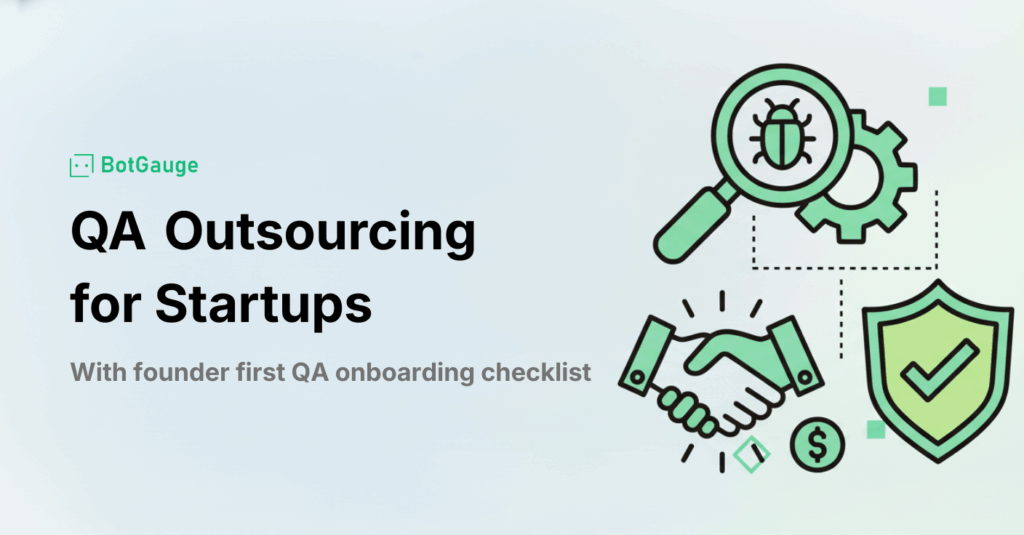Anyone can automate end-to-end tests!
Our AI Test Agent enables anyone who can read and write English to become an automation engineer in less than an hour.
Table Of Content

Table Of Content
Startups face a relentless battle to balance speed, quality, and cost. As a founder, scaling software quality quickly, without draining your runway or bogging down engineers, can define your company’s trajectory. The old “test everything in-house” approach is expensive and slow. Traditional outsourcing promises cost efficiency but often disappoints with misaligned incentives. Today, outcome-based, AI-driven QA outsourcing for startups is rewriting the rulebook, letting you pay only for results and reach 80%+ test coverage in just two weeks.
QA outsourcing for startups means engaging external teams, services, or platforms to handle your software testing—from regression and performance to continuous integration. Traditionally, this meant offshoring manual work. Today, with AI-driven and intelligent testing platforms, founders can tap into on-demand automation and codeless workflows that deliver higher coverage, faster execution, and lower total cost.
For founders, three drivers typically decide the move to QA outsourcing:
Many startups struggle to keep pace with manual QA, see coverage drop with every sprint, and miss bugs in production. An AI-powered, outcome-driven partner keeps product quality high with less managerial drag and no surprise billing.
| Approach | Coverage | Cost | Speed | Human Input | Best Fit |
| In-House QA | Moderate | High | Slow | 100% | Large, legacy apps |
| Traditional Outsourcing | Good | Medium | Moderate | 80-90% | Standard businesses |
| AI-Driven (BotGauge) | Excellent | Outcome-based | Fastest | 20-30% | Startups, SaaS |
Each startup has unique constraints and product goals, so selecting the right outsourcing approach matters:
Pros and Cons Table:
| QA Outsourcing Model | Pros | Cons | Best For |
| In-House QA | Full control, deep product knowledge | High cost, slow to scale, requires team management | Large organizations with steady QA needs |
| Traditional Outsourcing | Cost-effective, access to skilled testers | Mostly manual, slower ramp-up, less flexibility | Stable products, limited budgets |
| Hybrid Low-Code+QA Outsource | Faster cycles with partial automation | Needs some in-house oversight, test maintenance overhead | Growth-stage startups, SaaS |
| AI-Led End-to-End Outsource (BotGauge) | High automation (70%+), 80%+ coverage in 2 weeks, outcome-based pricing | Requires AI workflow adoption, less manual exploratory testing | Agile startups, SaaS, founders prioritizing speed and efficiency |
Today, nearly all areas of QA can be outsourced, many can even be automated:
For founders, the rise of AI-first QA brings unprecedented benefits:
Founders must focus on:
Simple Evaluation Table:
| Partner Type | Agility | Automation Depth | Dashboard/Reporting | Startup Alignment |
| Manual Outsourcing | Moderate | Low | Basic | Variable |
| Hybrid | Good | Medium | Good | Good |
| AI-Driven | Excellent | High | Excellent | Outstanding |
As a founder, embracing outcome-based, AI-first QA outsourcing is the competitive edge for 2025 and beyond. Speed, quality, and transparency aren’t mutually exclusive, BotGauge’s platform offers them in harmony, bringing 80% coverage in two weeks, and letting your team focus on winning. Make outcome-driven QA the growth accelerator in your startup journey, start a pilot with BotGauge today and ship with confidence, every time.
Outsourcing QA lets founders avoid high recruitment, training, and tooling costs. It accelerates time to market by providing specialized expertise instantly and frees internal teams to focus on core development and innovation.
Costs vary, but outcome-based models mean you pay only for actual test cases executed or coverage achieved. This flexible pricing aligns spending directly with your startup’s milestones and reduces wasted budget on idle resources.
Startups can outsource manual, functional, regression, performance, security, usability, and CI/CD testing. AI-led platforms also enable exploratory and risk-based continuous testing without increasing overhead.
BotGauge and similar platforms reach 80%+ automated coverage typically within two weeks, dramatically faster than traditional outsourcing. This enables founders to get rapid feedback and shorter release cycles.
Risks include lack of transparency, reduced control over test quality, communication breakdowns, and security non-compliance. Choosing partners with clear SLAs, real-time dashboards, and strong data governance mitigates these risks.
Founders pay based on delivered outcomes, such as number of tests run or percentage of application coverage, offering clear ROI. This model minimizes upfront cost, aligns cost with product development speed, and avoids paying for unused capacity.
AI handles about 70% of repetitive and regression testing autonomously, while humans focus on exploratory, edge cases, and judgment calls. This hybrid model improves efficiency without sacrificing testing depth or quality.
Key KPIs include test coverage percentage, number of bugs found pre-release, time to test cycle completion, bug leak rate post-release, and QA cost as a percentage of development spend.
Look for partners offering fast ramp-up, strong automation, transparent reporting, startup-friendly adaptive processes, and clear outcome-based pricing. Cultural fit and toolchain integration are critical for smooth collaboration.
AI agents automate test creation, execution, and maintenance, cutting human hours by up to 70%. They enable continuous testing integrated with CI/CD and self-healing tests, speeding coverage growth and lowering costs with pay-for-outcome models.
Share
Curious and love research-backed takes on Culture? This newsletter's for you.
View all Blogs
Our AI Test Agent enables anyone who can read and write English to become an automation engineer in less than an hour.